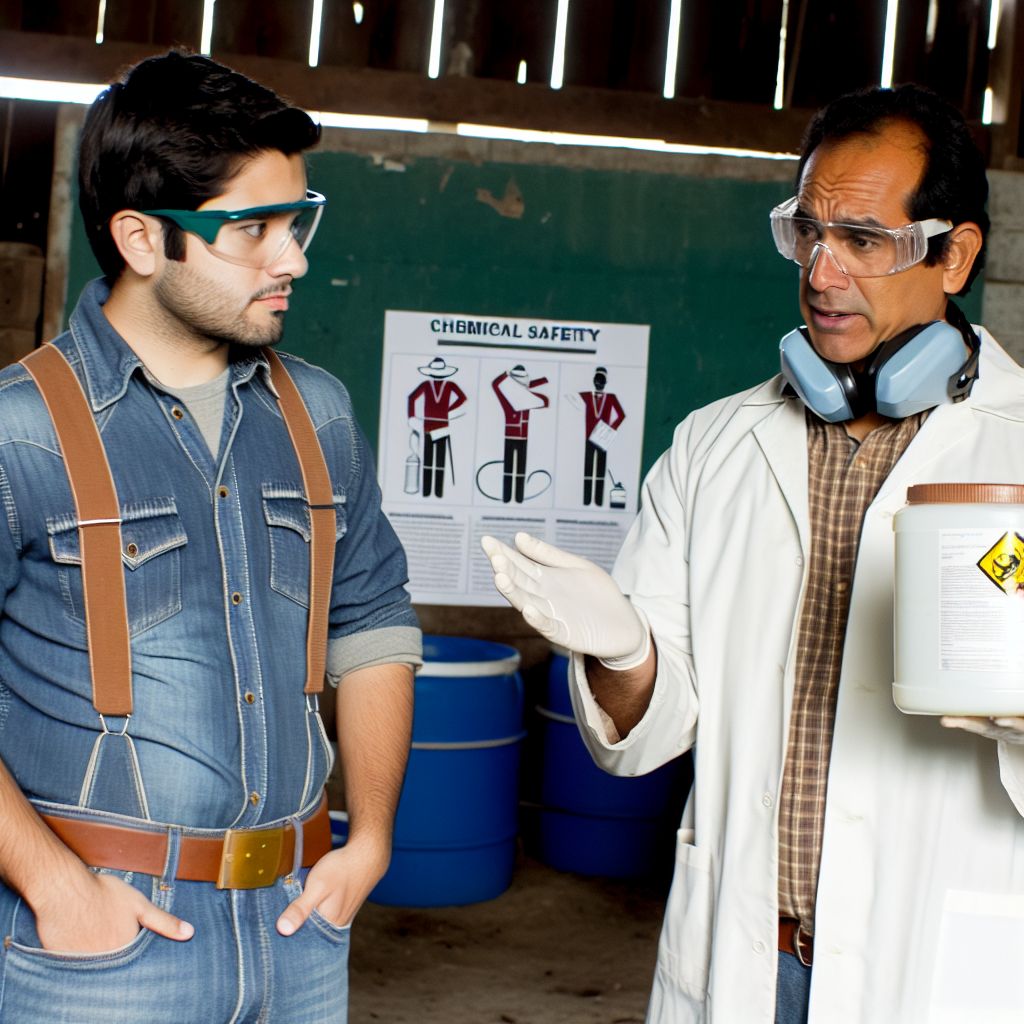Introduction to Chemical Safety in Farming
Chemical safety is essential in the agriculture sector.
It protects farm workers from potential hazards.
Farm workers often handle pesticides and fertilizers.
These substances can pose serious health risks.
Understanding chemical safety is crucial for prevention.
Proper training mitigates workplace accidents significantly.
Farm workers must know how to use chemicals safely.
The Risks of Chemical Exposure
Chemical exposure can lead to severe health issues.
These may include respiratory problems and skin irritations.
Long-term exposure can result in chronic diseases.
Additionally, some chemicals can threaten reproductive health.
Understanding risks is the first step in prevention.
Importance of Proper Training
Training enhances awareness among farm workers.
It equips them with knowledge on safe practices.
Workers learn about proper handling techniques.
Transform Your Agribusiness
Unlock your farm's potential with expert advice tailored to your needs. Get actionable steps that drive real results.
Get StartedFurthermore, they gain insight into emergency procedures.
Such training reduces incidents and promotes safety culture.
Regulatory Compliance and Best Practices
Compliance with regulations is mandatory in farming.
It helps maintain a safe working environment.
Farm owners must provide adequate chemical safety training.
Following industry best practices ensures worker safety.
Regular training updates are also necessary.
Promoting a Safe Work Environment
A safe work environment fosters productivity and morale.
Employers should prioritize health and safety protocols.
Providing protective equipment further enhances safety.
Encouraging open communication about safety concerns is vital.
In doing so, a proactive safety culture develops.
Understanding Different Types of Chemicals Used in Agriculture
Pesticides
Pesticides play a crucial role in crop protection.
Farmers use them to control pests, weeds, and diseases.
These chemicals help maximize crop yields.
However, they can pose risks to human health and the environment.
Proper training on pesticide application is essential.
Fertilizers
Fertilizers provide essential nutrients for crop growth.
They enhance soil fertility and overall plant health.
Farmers often choose between organic and synthetic options.
Too much fertilizer can lead to nutrient runoff.
This runoff can contaminate water sources.
Educating farm workers about proper usage is vital.
Herbicides
Herbicides specifically target unwanted plants.
Showcase Your Farming Business
Publish your professional farming services profile on our blog for a one-time fee of $200 and reach a dedicated audience of farmers and agribusiness owners.
Publish Your ProfileUsing this chemical helps maintain crop productivity.
Identifying the right herbicide is key for effective control.
Farm workers must learn the specific applications for safety.
Understanding potential side effects helps prevent accidents.
Growth Regulators
Growth regulators influence plant development.
They can enhance flowering or delay maturation.
Farmers use these chemicals to optimize harvests.
Safe handling of growth regulators requires training.
Farm workers must know the recommended dosages.
Adjuvants
Adjuvants improve the effectiveness of agricultural chemicals.
They help pesticides stick to plant surfaces better.
Farmers often combine adjuvants with sprays for better results.
Awareness of safe mixing practices is crucial.
Farm workers should receive guidance on their use.
Legal Regulations and Guidelines for Chemical Use in Farming
Overview of Chemical Safety Regulations
Farmers must comply with various regulations regarding chemical use.
These regulations aim to protect both workers and the environment.
The Environmental Protection Agency (EPA) sets many federal guidelines.
State regulations can also impose additional requirements.
Key Federal Legislation
The Federal Insecticide, Fungicide, and Rodenticide Act governs pesticide registration.
This act ensures that chemicals are safe for agricultural use.
The Occupational Safety and Health Administration (OSHA) mandates worker safety standards.
OSHA regulations specify how to handle harmful substances on farms.
State-Specific Regulations
Each state has its own set of rules regarding chemical use.
Farmers should consult their state agricultural department for details.
Many states require specific training programs for farm workers.
These training programs often focus on local environmental concerns.
Importance of Training Programs
Training programs provide essential knowledge about safe chemical handling.
They ensure farm workers can recognize hazardous situations.
Proper training reduces the risk of accidents and health issues.
Workers also learn how to use personal protective equipment effectively.
Documentation and Record-Keeping
Maintaining accurate records is crucial for compliance with regulations.
Farmers must document all chemical applications on their fields.
This documentation includes dates, quantities, and types of chemicals used.
Good record-keeping practices help in case of inspections.
Enforcement of Regulations
Regulatory agencies conduct inspections to ensure compliance.
Violations can result in fines or operational restrictions.
Farmers are encouraged to stay informed about changing regulations.
Regular training updates help maintain compliance and safety.
Find Out More: Sustainable Farming and Regulatory Compliance
Identifying Potential Hazards
Personal Risks for Farm Workers
Farm workers face numerous personal risks while handling chemicals.
Showcase Your Farming Business
Publish your professional farming services profile on our blog for a one-time fee of $200 and reach a dedicated audience of farmers and agribusiness owners.
Publish Your ProfileExposure to pesticides can lead to acute and chronic health issues.
Furthermore, improper use of protective gear increases these risks.
Workers must also be aware of chemical spill age and exposure routes.
Skin contact can cause irritation or allergic reactions.
Additionally, inhaling chemical vapors can lead to respiratory problems.
Environmental Risks
The use of chemicals on farms poses environmental hazards.
Chemical runoff can contaminate nearby water sources.
This runoff can have detrimental effects on aquatic life.
Moreover, inappropriate disposal of chemical containers can pollute the soil.
Practices like aerial spraying can drift and affect non-target areas.
Identifying Specific Chemicals
Knowing the specific chemicals used is crucial for safety.
Common herbicides, insecticides, and fungicides carry various risks.
Farm personnel should read safety data sheets for each product.
Understanding chemical properties helps to assess potential hazards.
Assessing Situational Risks
Situational risks can arise from weather and operational conditions.
High winds can increase the drift of sprayed chemicals.
Current soil moisture levels can affect chemical absorption rates.
Additionally, working in poorly ventilated areas can heighten exposure.
Explore Further: Impact of Climate Legislation on Crop Production
Best Practices in Handling and Storing Chemicals on Farms
Understanding Chemical Safety
Farm workers must know the risks associated with chemical exposure.
Education is essential to prevent accidents and health issues.
Proper training fosters a culture of safety on farms.
Using Personal Protective Equipment
Personal protective equipment (PPE) is crucial for chemical handling.
Workers should wear gloves, goggles, and masks designed for chemical use.
Additionally, proper clothing prevents skin contact with harmful substances.
Regularly inspect PPE for tears and damages to ensure effectiveness.
Proper Storage Techniques
Careful storage of chemicals enhances safety on farms.
Keep chemicals in original containers with clear labels.
Store them in well-ventilated areas away from children and animals.
Further, maintain an organized storage space to prevent spills.
Labeling and Signage
Clear labeling helps workers identify chemicals quickly.
Use internationally recognized symbols for hazardous materials.
Post safety signs in storage areas and near application fields.
This practice reinforces the importance of safety protocols.
Emergency Procedures and Training
Effective emergency response plans are vital for all farms.
Conduct regular training sessions on dealing with chemical spills.
Workers should know how to use safety showers and eye wash stations.
Maintain an accessible first aid kit for immediate response needs.
Regular Safety Audits
Conducting regular safety audits helps identify potential hazards.
Document all findings and address issues promptly.
Showcase Your Farming Business
Publish your professional farming services profile on our blog for a one-time fee of $200 and reach a dedicated audience of farmers and agribusiness owners.
Publish Your ProfileThis practice cultivates a proactive safety culture on the farm.
Engage workers in the audit process for comprehensive insights.
Continuous Education and Training
Ongoing education ensures that workers stay informed about chemical safety.
Provide updates on new safety practices and regulations.
Encourage participation in workshops and safety courses.
This commitment fosters a knowledgeable workforce dedicated to safety.
Gain More Insights: Comprehensive Guide to Securing Research and Development Funding for Farmers

Emergency Response Procedures for Chemical Exposure Incidents
Immediate Actions
Farm workers must react swiftly in case of chemical exposure incidents.
First, they should assess the situation for safety.
Next, they need to notify a supervisor or emergency response team immediately.
Once trained, workers can use safety equipment, like eye wash stations and safety showers.
Additionally, identifying the chemical involved is crucial for further action.
Evacuating the Area
If chemical exposure occurs, evacuate all non-essential personnel from the area.
This action minimizes potential harm to others nearby.
Follow designated evacuation routes to ensure safety.
Always stay calm and assist others who may need help evacuating.
First Aid Procedures
First aid is essential in addressing chemical exposure injuries.
For skin contact, immediately remove contaminated clothing.
Then, rinse the affected skin with water for at least 15 minutes.
For eye exposure, use an eye wash station or clean water to flush the eyes.
In any case of respiratory distress, move the affected person to fresh air.
Reporting the Incident
After managing immediate responses, reporting the incident is imperative.
Fill out an incident report detailing the exposure circumstances.
This documentation aids in understanding and preventing future incidents.
Include all relevant details, such as the chemical name and exposure duration.
Review and Improve Procedures
Following an incident, review the emergency response procedures thoroughly.
Identify any gaps or weaknesses in the current protocols.
Then, update the training programs for all farm workers accordingly.
Regular drills can enhance preparedness and response efficiency.
Continuously improving safety measures protects both workers and the environment.
See Related Content: Enhancing Farming Operations with Rural Development Policies
Training Methods and Tools for Effective Learning of Chemical Safety
Understanding Chemical Safety Training
Chemical safety training equips farm workers with essential knowledge.
It focuses on the proper handling of hazardous substances.
Workers learn to identify different chemicals and their risks.
Effective training enhances workplace safety and compliance.
Interactive Learning Techniques
Hands-on activities engage workers actively in the learning process.
Simulations allow participants to practice safety protocols realistically.
Group discussions foster collaboration and deeper understanding.
Additionally, interactive tools help reinforce key concepts.
Utilizing Technology
Digital platforms provide flexible training options for workers.
Showcase Your Farming Business
Publish your professional farming services profile on our blog for a one-time fee of $200 and reach a dedicated audience of farmers and agribusiness owners.
Publish Your ProfileOnline courses allow self-paced learning for better retention.
Webinars enable expert-led training regardless of location.
Moreover, mobile apps offer quick access to chemical safety resources.
Visual Learning Aids
Visual aids enhance comprehension of complex information.
Infographics summarize critical safety information concisely.
Posters can serve as constant reminders in work areas.
Videos demonstrate safe practices effectively and engagingly.
Printed Materials
Handbooks provide detailed guidance on chemical safety procedures.
Checklists ensure workers follow safety steps consistently.
Brochures can distribute key safety tips and emergency contacts.
Evaluating Training Effectiveness
Assessments measure the knowledge gained after training.
Quizzes encourage retention and identify areas needing improvement.
Feedback from participants provides insights into the training experience.
Regular reviews promote continual improvement of the training program.
Ongoing Education and Refreshers
Importance of Training
Training farm workers on chemical safety is crucial for their protection.
It ensures they understand the risks associated with chemical exposure.
Regular training helps reinforce the importance of safety practices.
Creating a Training Schedule
Establish a consistent training schedule for all workers.
Include both initial training and periodic refreshers.
This approach keeps safety information fresh in their minds.
Key Topics to Cover
Focus on essential topics during training sessions.
- Understanding chemical labels and safety data sheets.
- Personal protective equipment (PPE) usage and maintenance.
- First aid procedures for chemical exposure incidents.
- Proper storage and disposal of chemicals.
Utilizing Various Training Methods
Engage workers using different training formats.
Consider in-person workshops, online courses, or hands-on demonstrations.
This variety caters to different learning styles among workers.
Assessing Knowledge Retention
Regularly evaluate workers’ understanding of safety practices.
Use quizzes, discussions, or practical tests to gauge their knowledge.
Address any gaps to ensure comprehensive understanding.
Feedback Mechanisms
Encourage workers to share their feedback on training sessions.
This input can improve future training programs.
It also empowers workers by involving them in safety processes.
Engaging External Experts
Consider collaborating with chemical safety experts for training sessions.
They offer valuable insights and updated industry standards.
This collaboration enhances the overall quality of the training program.
Additional Resources
Rural Agricultural Health and Safety Overview – Rural Health …




